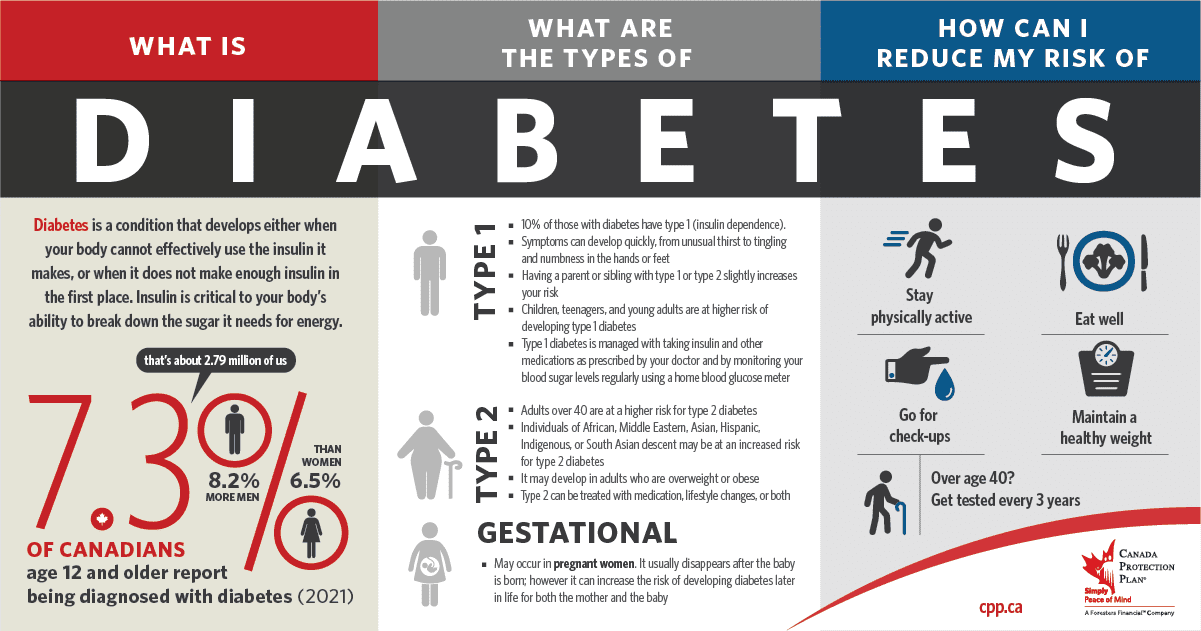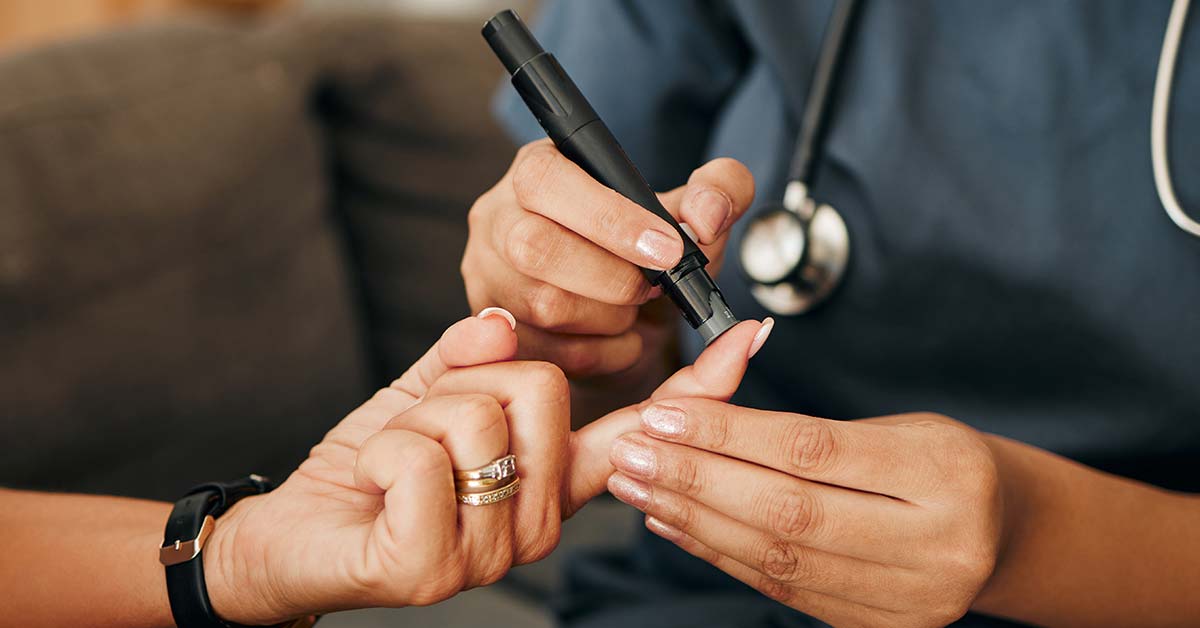Whether you have diabetes or other health conditions, you can be covered by one of our life insurance plans!
Applying is easy
No medical life insurance for up to $500,000 in coverage
18 or 80, you can apply! This includes temporary residents with a valid work or study permit
Get a free no-obligation quote
How Much Control Do We Have Over Diabetes?
Conventional wisdom about treating and controlling diabetes, especially Type 2 diabetes, constantly changes. Researchers are finding a lot of evidence that supports the use of glucose-lowering drugs to help control blood sugar as the most important way to fight Type 2 diabetes.
But while the research continues into the treatment and eventual curing of diabetes, Canadians living with this disease need to take necessary precautions, both medical and financial.
Securing life insurance protection for your loved ones while living with diabetes isn’t just possible, it’s also simple and affordable – and it doesn’t involve needles or blood tests.
Fill out the form on this page and get a free quote today!
Additional information on Diabetes
Diabetes in Canada
Here are the most recent nationwide statistics on diabetes in Canada:
- During the most recent years for which complete data was available (2013-2014), almost 3.0 million Canadians (8.1 percent) were living with diabetes.
- About 20 percent of diabetes cases are undiagnosed.
- Although diabetes rates increased with age, more than 50 percent of Canadians with diabetes (1.2 million) were between 25 and 64 years old.
- More men (8.7 percent) than women (7.6 percent) have diabetes.
- Between 1998 – 1999 and 2008 – 2009, the number of diagnosed diabetes in Canada increased by 70 percent. The biggest relative increase was among 35 to 44 age group, where the incidence of diabetes doubled.
- In 2013 – 2014, there were close to 200,000 new cases of diabetes in Canada (5.9 cases per 1,000 people).
- If 2008 – 2009 incidence and mortality rates hold, the number of Canadians living with diabetes will reach 3.7 million by 2018 – 2019.
What is diabetes?
Diabetes is a condition that develops either when your body cannot effectively use the insulin it makes, or when it does not make enough insulin in the first place. Insulin is critical to your body’s ability to break down sugar it needs for energy. Without insulin, sugar builds up in the blood.
What are the types of diabetes?
There are three kinds of diabetes:
- Type 1 diabetes happens when the pancreas no longer makes insulin. It usually develops in children, teenagers, and young adults. About 10 percent of people who have diabetes have Type 1 diabetes, which is treated with insulin.
- Type 2 diabetes happens because although the pancreas still makes insulin, it does not make enough, or if it does, the body cannot effectively use that insulin. It typically develops in adults who are overweight. About 90 percent of people who have diabetes have Type 2, which may be treated with medication, lifestyle changes, or both.
- Gestational diabetes occurs in 2 to 4 percent of pregnant women. It usually disappears after the baby is born, but it can increase the risk of developing diabetes later in life for both the mother and the baby.
What is prediabetes?
Diabetes isn’t the kind of health problem that is present or not present like a light switch is on or off; as your blood glucose rises and gets close to the high levels associated with diabetes, you will eventually be in the prediabetes range. Prediabetes is also called Impaired Fasting Glucose (IFG) or Impaired Glucose Tolerance (IGT).
Prediabetes is not the same as diabetes, but it may mean that you are at increased risk for developing diabetes, and that you should make lifestyle changes and get your blood glucose levels tested more frequently.
1 https://www.canada.ca/en/public-health/services/publications/diseases-conditions/diabetes-canada-highlights-chronic-disease-surveillance-system.html
2https://www.canada.ca/en/public-health/services/chronic-diseases/reports-publications/diabetes/diabetes-canada-facts-figures-a-public-health-perspective/chapter-1.html
Who is at risk?
Type 1 diabetes is typically diagnosed in people age 30 and under, most often in children. It’s nearly always caused when the body attacks the cells of its own pancreas in an autoimmune reaction. It is not caused by eating sugar, or anything else related to lifestyle because it has to do with this autoimmune issue. Right now, there is no effective way to prevent Type 1 diabetes. Fortunately, only 10 percent of people with diabetes are coping with this kind.
Type 2 diabetes is most common in people age 40 and over, although numbers among young people, including children, are rising. Most children with Type 2 diabetes belong to ethnic groups that are generally at higher Type 2 diabetes risk, particularly First Nations, African, Latino, Asian, and South Asian populations.
It’s a good idea for anyone over age 40 to have their fasting blood glucose screened every three years. Your blood glucose should be checked more often if you have one or more risk factors for diabetes, such as:
- a close relative (parent or sibling) with Type 2 diabetes
- membership in a high-risk ethnic group
- prediabetes
- a history of gestational diabetes
- vascular disease
- high blood pressure
- high blood cholesterol
- overweight and/or abdominal obesity
- giving birth to a baby larger than 4 kg or 9 lb.
- schizophrenia
- polycystic ovaracanthosis nigricans (skin folds or darkened patches of skin in places such as the arm pit)
Symptoms of diabetes
Wondering if you might have undiagnosed diabetes? The best thing to do is visit your doctor. However, the earliest symptoms are typically:
- frequent urination
- excessive thirst
- dry mouth
- feeling tired most of the time
These are often followed by:
- frequent infections
- blurry vision
- weight gain (usually in Type 2)
- weight loss, despite increased hunger (usually in Type 1)
- nausea
- vomiting
- loss of appetite
- tingling in hands and/or feet
- fruity-smelling breath (usually in Type 1)
When diabetes is a possible diagnosis, it can be confirmed with laboratory tests of the blood and urine.
What other health problems are linked to diabetes?
- Diabetes increases the risk of stroke and heart disease. In fact, about 80 percent of people with diabetes will die from stroke and heart disease. People with diabetes are over three times more likely to be hospitalized with cardiovascular disease.
- Diabetes is also the top cause of non-traumatic amputation, kidney failure, and blindness. People with diabetes are more than 12 times more likely to be hospitalized with end-stage renal disease, and almost 20 times more likely to be hospitalized with non-traumatic lower limb amputations. Diabetes was found to be the primary cause of over 30 percent of new cases of end-stage renal disease.
- 36.5 percent of Canadians with diabetes have two or more other serious chronic conditions such as arthritis, chronic obstructive pulmonary disease, heart disease, hypertension, and/or mood disorder, and 12.5 percent have three or more.
- Almost 40 percent of Canadian adults with diabetes rated their health as “fair” or “poor,” but only about one-tenth of the adult population without diabetes did so (10.3 percent).
- Diabetes itself does not usually lead directly to death, but its complications do.
- For every age group, people with diabetes experienced mortality rates at least two times higher than those without.
- More than one in ten deaths in Canadian adults would be prevented if there were no cases of diabetes.
How can I reduce my risk for diabetes?
You can’t change your genes or your age, but you can control many risk factors for diabetes. Reducing or eliminating risk factors will lessen your chances of developing Type 2 diabetes. That will, in turn, reduce the chances you suffer from complications of diabetes such as stroke and heart disease.
The best way to reduce the affects diabetes can have on your health is by attacking your other risk factors:
- If you fall within multiple risk factor categories, get your doctor to test your blood sugar levels. Don’t put it off or ignore the possible problem.
- Maintain a healthy weight, and lose weight if you need to.
- Talk to a registered dietitian if you don’t know enough about healthy eating. Your doctor can probably refer you to one.
- Work closely with your healthcare provider to set and meet goals for your blood glucose. Always know what your target levels are.
- Find out how to monitor your blood glucose and let your doctor know if you cannot manage it yourself.
- Be physically active. Your doctor can help you design a program that will work for you.
Can diabetes be “cured”?
Diabetes doesn’t have a cure per se, but it can be controlled, and it can even go into remission. Being in remission just means you experience no symptoms, although your risk of relapse is high. That’s why even patients with diabetes in remissions should take the same preventative steps and make the same healthy choices as people with active Type 2 diabetes should do.
Keys to control
Living a “diabetes-healthy” lifestyle allows some people to stay healthy and control their blood sugar levels enough to manage diabetes, or even put it into remission. That “diabetes-healthy” lifestyle means staying physically active, eating healthy foods, and maintaining a healthy weight. Many people with Type 2 diabetes also require insulin and one or more other medications.
What is remission?
For those who don’t need medication for their diabetes and who seem to see a “reversal” with exercise, weight control, and healthy eating, their diabetes might be in remission. Remission is most likely to happen after a major weight loss or bariatric surgery. There is no way to predict whether or not remission is possible for a specific person, although it is less likely for people who are very overweight. Still, since it’s possible for most diabetics and healthy habits are most likely to cause it, it makes good sense to “make an effort” for remission by controlling your diabetes as well as possible.
Although the Canadian Diabetes Association does not promulgate guidelines about remission,
The American Diabetes Association does:
Normal A1c and fasting glucose levels without medication are the standards for remission; one year or more of achieving those goals is called “complete remission” and five years or more is called “prolonged remission.” Even if you have complete remission, you will still need regular testing or checks for high blood sugar, high cholesterol, high blood pressure, and eye, kidney, and foot problems. If you are lucky enough to enjoy “prolonged remission,” you may get less frequent lab tests, but your doctor will still monitor you for diabetes-related health problems like heart, foot, eye, and kidney issues, especially if you had them before.
Remission-friendly tips
Keep carbs in check. Manage what kind of carbohydrates you eat, and how much of them. Don’t eat all of your day’s carbs at once; spread them throughout your day.
Mix it up. Carbohydrates can be dangerous because they raise your blood sugar faster and higher than other nutrients, so mix it up. Eat foods with fat, fibre, and protein instead as much as you can.
Keep moving. Your body uses sugar when you are active, and being active also helps you maintain your weight and lower your blood sugar. You may need less medication the more you exercise.
Be A1c wise. The A1c test, which is usually given twice a year, measures your average blood sugar level over the months before the test. It basically is a test that provides a bigger picture of your blood sugar levels.
See your doctor. Even for people who are very effective at controlling their blood sugar, certain risks like heart disease are still higher in people with diabetes. This means it’s crucial to go to all of your appointments and work closely with your doctor.
Physical activity and food
Physical activity and diabetes
Engaging in regular physical activity is one of the best ways you can manage your diabetes and live well in spite of the disease. For people living with type 2 diabetes, regular exercise has special advantages. It can delay or even prevent type 2 diabetes from developing, and it helps manage your blood sugar levels. It also improves the body’s sensitivity to insulin. In fact, fitness level is one of the strongest mortality indicators in people with diabetes.
Physical activity is also a powerful tool; it can work just as well as glucose-lowering medication, and without side effects. Along with weight management and healthy eating, regular physical activity can reduce the occurrence of Type 2 diabetes by 60 percent.
“Physical activity” that benefits diabetes sufferers doesn’t have to be a major workout. Anything that’s physical helps, including taking the stairs, cleaning the house, walking in the parking lot, gardening, walking the dog, and more. Both resistance and aerobic exercise are important for living with diabetes.
Aerobic exercise just means continuous movement that brings your breathing and heart rate up, like walking, running, or biking. Resistance exercise means weight-bearing or resistance using the body’s weight to build strength in the muscles, such as weightlifting or pushups. Obviously, some kinds of exercise offer both aerobic and resistance benefits.
Aim for about 150 minutes of moderate to intense aerobic exercise each week, split up into five 30-minute periods. Don’t start at this rate if you’re not ready! You can work up from 5 to 10 minutes of moderate exercise per day as you are ready. After you’ve gotten up to speed with your aerobic exercise, you can add in resistance exercise three times each week. Remember, ask your doctor before you start any kind of exercise program if it’s been awhile.
Best foods for battling diabetes
Research shows that making critical changes to your diet can help prevent diabetes if you don’t have it yet and reduce the risk of complications from the disease if you’ve been diagnosed already. Eating more produce, plenty of lean protein, fewer refined carbohydrates, and more healthy fats helps control blood sugar levels and reduces your risk. Don’t think eating one kind of healthy food will do it; you need to transform your entire diet. Here are some great foods to start with:
Eggs. A fantastic, inexpensive source of high-quality protein. In fact, nutritionists use the egg as the gold standard to rank all other proteins against. A few eggs here and there won’t hurt your cholesterol levels, and they will keep you feeling full for hours.
Apples. Naturally high in fibre and low in calories, this sweet, crispy treat fills you up healthfully, fights bad cholesterol, and calms down those blood-sugar swings. They’re even high on the list of fruits with antioxidants.
Sweet potatoes. Substituting a baked sweet potato in place of a white potato will mean your blood sugar rises around 30 percent less. Filled with nutrients and fibre, these keep you going and feeling full as they lower your cholesterol. Naturally orange foods like sweet potatoes are also rich in carotenoids, which help the body respond more effectively to insulin.
Oatmeal. Oatmeal is loaded with soluble fibre which means your body takes longer converting the carbs in it into blood sugar. You can also grind up oatmeal in your blender until it’s powder, and use it to thicken soups or add it to things like pancake batter.
Broccoli. This oft-maligned veggie is packed with antioxidants, including a whole day’s worth of vitamin C in a single serving, it is also fibre-filled, giving you that full feeling. Broccoli is also rich in chromium, which is important to blood sugar control.
Avocado. One of the best sources of healthy fat, avocado gives you a creamy, rich fix while slowing your digestion and preventing a blood sugar spike. A diet high rich in good fats like avocado can even help reverse insulin resistance.
Flaxseed. Don’t shy away from flaxseed just because it’s a new one; it’s rich in healthy fats, protein, and fibre. It’s also a great source of magnesium, which helps cells use insulin.
Peanut butter. This favorite dampens the appetite for hours, and its monounsaturated fats also help control blood sugar.
Barley. Substitute barley for white rice to drop your post-meal blood sugar rise by almost 70 percent. The soluble fibre and other nutrients in barley also keep your blood sugar steadier and lower for hours. And yes, barley beats even brown rice.
Fish. Eating fish just once a week can reduce your risk of heart disease by 40 percent, and heart disease is the single deadliest complication of diabetes. Fish is filled with fatty acids that reduce inflammation and insulin resistance.
Whole-grain bread. Eating whole-grain bread instead of white bread can improve your sensitivity to insulin and blood-sugar stability. Remember, advertising can be misleading; if it doesn’t say “whole” in the first ingredient, skip it.
Beans. Eat beans, which are filled with soluble fibre, at least twice a week. That much fibre keeps blood sugar low, and they’re filled with protein, too.
Poultry. Chicken and turkey in particular, especially white meat, is low fat and high protein. Skip the skin and dark meats.
Berries. Delicious, juicy berries are packed with antioxidants and fibre, satisfying your sweet tooth, your sense of hunger, and your need for nutrients. The red and blue varieties also may boost insulin production because they contain natural plant compounds called anthocyanins.
Milk and yogurt. Rich in calcium and protein, these help you lose weight, and could fight insulin resistance. Choose low-fat or fat-free options.
Olive oil. Olive oil contains healthy fats and a strong anti-inflammatory component. Olive oil also slows digestion, reducing your chances of a glucose spike.
Nuts. Nuts will keep you going strong thanks to their high protein and fibre content. They are high in fat, but it’s healthy fat.
Carrots. Carrots are extremely low in sugar and extremely high in fibre and beta-carotene, which is linked to better blood-sugar control and a lower risk of diabetes.
Seeds. Seeds of all varieties are filled with protein, good fats, and fibre that together stave off heart disease and keep blood sugar low.
Diabetes and alcohol
If you wish to consume alcohol and you have diabetes, it’s critical to ask your doctor about this. You’ll want to know if you can safely drink at all, and if so, what specifically you should be drinking and how much. Do not drink without consulting your doctor.
How does alcohol affect the diabetic body?
- The alcohol goes from your stomach into your bloodstream.
- The liver begins to break the alcohol down.
- Alcohol builds up when you drink faster than your liver works. As your blood alcohol rises, your liver works harder.
- If your blood sugar drops from extra activity like dancing or from lack of food, the pancreas makes a hormone called glucagon which triggers the liver to make more sugar. However, if the liver is too busy breaking down alcohol, it won’t react to the glucagon.
- Symptoms of low blood sugar look a lot like drunkenness; you might not even notice that your blood sugar is low.
- If your blood sugar drops too much, you can lose consciousness.
Why is drinking alcohol risky for diabetes control?
Alcohol can have a number of effects:
- it can increase the risk of low blood sugars, especially if you take insulin or some other kinds of diabetic medications
- it can increase the risk of low blood sugar after you drink, overnight, and the morning after
- it can interact with some medications and cause side effects
- it can worsen certain conditions such as liver disease, neuropathy, pancreatitis, and ulcers
- it can increase your triglyceride levels if you drink regularly; high levels of triglycerides can increase your risk for heart disease
- it can prevent weight loss and lead to weight gain
How can you prevent these risks?
There are some best practices that can help you drink alcohol more safely, although you should always check with your doctor, and never drink against medical advice:
- follow your normal diabetes routine including eating regular meals, taking insulin and medications, and testing
- wear a medical alert bracelet so people around you know you have diabetes; make sure someone you’re with knows what to do if you appear to have low blood sugar
- always carry your glucometer, and a simple carbohydrate with you, and tell your companions where it is
- drink alcohol with food, and eat more if you are active
- never take extra insulin to “make up for” the alcohol
- use mixers that do not contain carbohydrates such as water, soda water, and diet soda
- alternate alcoholic and non-alcoholic drinks
- limit yourself to 1 or 2 drinks at one time
- test your blood sugar before going to bed, and eat a snack with carbohydrates before you sleep if it is low
Reliable, trusted and affordable life insurance no matter your health condition. Apply today.
WEB256-0521EN

Call us today!
Send us an email or call us for a no obligation quote toll-free at 1-877-851-9090












